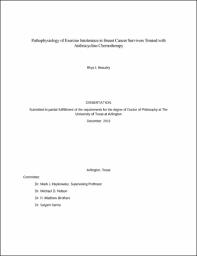| dc.description.abstract | Anthracyclines emerged as frontline breast cancer adjuvant therapy in the late 1960’s. Within half a decade of their clinical adoption, dose-limiting cardiotoxicity was recognized and cumulative dose limits were established to acceptably balance anti-tumor and cardiotoxic properties. Despite these longstanding dose limits, anthracycline treated breast cancer (BC) survivors have advanced biological aging, as evidenced by a marked impairment in peak oxygen uptake (VO2 peak). Given that the pathophysiology of reduced VO2 peak in BC is poorly understood, the aim of this dissertation was to: 1) develop a non-invasive imaging technique to investigate cardiac function under exercise stress; 2) investigate the cardiac limits to exercise in BC; and 3) investigate muscle blood flow, oxygen use, and bioenergetics as components of exercise intolerance in BC.
In study 1 (Chapter 2) an exercise cardiac magnetic resonance imaging (cMRI) technique was developed using commercially available hardware and in-product image sequences. Rest and exercising cardiac volumes were measured in eight young healthy subjects (mean age: 25 years) and a meta-analysis was performed to demonstrate consistency of results, thus demonstrating feasibility and establishing the normative cardiac response to supine exercise cMRI. From rest to exercise, cardiac output increased by an increase in heart rate and stroke volume, through preserved end-diastolic volume and reduced end-systolic volume. In study 2 (Chapter 3), using exercise cMRI and cardiopulmonary exercise testing, cardiac function and VO2 peak were measured in 29 BC patients (mean age: 48 years) prior to receiving anthracycline based chemotherapy and in 10 age- and sex-matched healthy controls. On average, BC patients had 20% lower VO2 peak (l/min or ml/kg/min) than healthy controls, which was related to lower peak exercise cardiac output. Importantly, decrements in peak cardiac output were apparent prior to anthracycline administration. In study 3 (Chapter 4), using femoral artery Doppler ultrasound, leg blood flow was measured during single-leg knee extension (SLKE) in 14 BC survivors (mean age: 61 years, mean time post anthracycline therapy: 12 years) and 9 age- and sex-matched controls. Peak SLKE power output, heart rate and blood pressure were comparable between groups. Leg (femoral artery) blood flow was measured during 25, 50 and 75% of peak SLKE, and was not significantly different between groups at rest or during submaximal exercise. However, estimated quadriceps muscle mass was reduced in BC survivors, despite normal leg blood flow and conductance. In study 4 (Chapter 5), using MRI, lower leg (superficial femoral vein) blood flow, VO2 and bioenergetics were measured during plantar flexion exercise in 16 BC survivors (mean age: 56 years, mean time post anthracycline therapy: 13 months) and 16 age-, sex- and body mass index matched controls. Muscle oxidative capacity was not impaired, nor was muscle blood flow or oxygen extraction. However, BC survivors tended to have abnormal leg composition (increased fat and reduced muscle) that contributed to reduced VO2 peak. Taken together, the data herein demonstrate a strong non-cardiac component to exercise intolerance in anthracycline treated BC survivors, similar to that found in sex- and age-matched controls. Future research building upon non-cardiac interventions for prevention of anthracycline related reductions in VO2 peak are needed to reduce cardiovascular risk in BC survivors. | |


